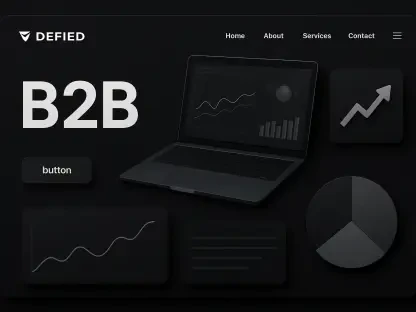Understanding Programmatic DOOH and Its Industry Context
In an era where environmental impact weighs heavily on corporate decisions, programmatic digital out-of-home (DOOH) advertising emerges as a beacon of sustainability in a carbon-intensive digital landscape. With digital advertising contributing roughly 4% to global greenhouse gas emissions from digital services, the quest for greener alternatives has never been more urgent. Programmatic DOOH, an automated approach to managing outdoor advertising through real-time bidding and data-driven strategies, offers a compelling solution that balances effectiveness with environmental responsibility, prompting industry leaders to take notice.
At its core, programmatic DOOH represents a modern evolution of outdoor advertising, leveraging technology to buy and place ads on digital screens in public spaces like transit hubs and urban centers. This method contrasts with traditional manual processes by automating transactions through platforms that connect advertisers with inventory in real time. Today, the DOOH industry boasts significant global reach, with major players like VIOOH operating across 35 markets and partnering with over 50 demand-side platforms, reflecting its growing influence in the advertising ecosystem.
Technological advancements such as dynamic creative optimization and real-time bidding have further shaped the landscape, allowing for tailored messaging and efficient ad delivery. Key collaborators, including Vengo and Broadsign, alongside demand-side platforms, drive innovation and expand access to premium inventory. Additionally, sustainability has become a central pillar, with the industry increasingly prioritizing low-carbon solutions to meet both regulatory pressures and consumer expectations for eco-conscious practices.
Carbon Efficiency Metrics of Programmatic DOOH
Comparing Emissions Across Advertising Channels
A striking revelation in the realm of sustainable advertising comes from VIOOH’s 2024 emissions intensity data, which pegs programmatic DOOH at a mere 0.041 grams of CO2 equivalent (CO2e) per ad impression. When juxtaposed with programmatic display advertising at 0.84g CO2e and video at 1.24g CO2e per impression, DOOH demonstrates over 20 times greater carbon efficiency than display and over 30 times more than video. This disparity underscores a transformative potential for advertisers seeking to minimize their environmental footprint.
The efficiency stems largely from the broadcast nature of DOOH, where a single advertisement displayed on a digital billboard can reach numerous viewers simultaneously in high-traffic locations. Unlike digital display or video, which often require individual data transmissions per user, DOOH distributes energy consumption across a broader audience, significantly lowering the per-impression carbon cost. This structural advantage positions it as a standout in media planning for sustainability-focused campaigns.
Measurement Standards and Industry Benchmarks
The credibility of these metrics hinges on standardized methodologies like the Global Media Sustainability Framework (GMSF) version 1.2, developed by Ad Net Zero. This framework provides a consistent approach to calculating emissions across the advertising delivery chain, from server usage to screen infrastructure. Third-party validations, such as those conducted by Cedara using log-level bidstream data, further enhance transparency and trust in the reported figures.
These standardized benchmarks not only validate current data but also pave the way for future industry norms. As advertisers increasingly rely on carbon efficiency metrics alongside traditional performance indicators, the adoption of DOOH is projected to grow, fueled by trust in consistent measurement practices. Such developments signal a shift toward integrating environmental impact into strategic decision-making across the sector.
Key Factors Driving Carbon Efficiency in Programmatic DOOH
One of the primary drivers behind programmatic DOOH’s impressive carbon efficiency is its shared audience model. By displaying content in bustling public spaces, a single ad can engage multiple viewers at once, unlike the one-to-one delivery of digital display or video ads. This inherent characteristic drastically reduces the energy required per impression, making DOOH a uniquely sustainable channel in high-visibility environments.
Additionally, platforms like VIOOH streamline the supply chain by minimizing intermediaries in the ad delivery process. Compared to traditional digital advertising, which often involves multiple layers of platforms and verification services, this leaner approach cuts down on computational demands and associated emissions. The result is a more direct and less resource-intensive path from advertiser to audience.
Further amplifying this efficiency is the integration of renewable energy sources to power many DOOH screens within extensive networks. Coupled with technological innovations such as real-time bidding and aggregated data measurement systems, which reduce unnecessary data processing, these efforts collectively bolster the channel’s low-carbon profile. Such advancements highlight how infrastructure and technology converge to support greener advertising practices.
Challenges and Barriers in Sustainable Advertising
Despite its advantages, programmatic DOOH faces hurdles in widespread adoption, notably a knowledge gap among industry professionals. Surveys indicate that 36% of marketing experts lack a clear understanding of this channel, which can deter investment and slow integration into broader media strategies. Bridging this gap remains a critical challenge for expanding its reach.
Beyond specific barriers to DOOH, the advertising sector grapples with the overarching issue of digital advertising’s substantial carbon footprint. As part of an industry where digital services contribute significantly to global emissions, finding scalable, low-impact alternatives is paramount. This context underscores the urgency of shifting toward channels that inherently produce fewer emissions without compromising on reach or effectiveness.
Solutions are emerging through initiatives like industry education, exemplified by IAB Australia’s programmatic DOOH buyer’s guide, and collaborations with carbon tracking firms such as Scope3 and Cedara. These efforts aim to equip advertisers with the tools and knowledge needed to prioritize sustainability. However, balancing cost, engagement, and environmental goals in media planning continues to present complex market-driven challenges that require nuanced approaches.
Regulatory and Industry Initiatives for Sustainability
A pivotal force in advancing sustainable advertising is the role of regulatory frameworks and collaborative initiatives like Ad Net Zero. By developing tools such as the GMSF, this organization ensures consistent emissions measurement across channels, fostering accountability. Such frameworks are vital for creating a level playing field where environmental impact can be fairly assessed.
This push for standardization is supported by a coalition of over 120 companies spanning 40 markets, working collectively to embed sustainability into advertising practices. Their combined efforts help align disparate approaches, ensuring that carbon reduction becomes a shared priority. The influence of these collaborations extends to shaping how brands and agencies evaluate their media choices.
Industry reports and white papers, such as those published by IAB Italia on digital sustainability, also play a significant role in guiding policy and compliance. These resources provide actionable insights that encourage advertisers to adopt greener practices while meeting regulatory expectations. As a result, there is a noticeable shift in behavior toward greater accountability and proactive carbon management within the sector.
Future Outlook for Programmatic DOOH and Sustainable Advertising
Looking ahead, programmatic DOOH is poised for robust growth, with adoption rates climbing in key markets like the United States, Brazil, and China, where penetration has already reached 30% as of this year. This trajectory suggests a broadening acceptance of the channel as a staple in global advertising strategies. Continued expansion into diverse regions will likely amplify its impact on sustainability goals.
Emerging technologies and strategic partnerships, such as Broadsign’s collaboration with StackAdapt for advanced DOOH booking capabilities, are set to further refine the channel’s efficiency and accessibility. These developments signal an ongoing maturation of infrastructure that supports both operational and environmental objectives. Innovation in this space remains a key driver for future scalability.
Amid rising demand for sustainable practices, programmatic DOOH stands out as a potential leader in low-carbon advertising. Factors like global economic conditions and consumer preference for eco-conscious brands will shape its evolution, pushing the industry to adapt. As these dynamics unfold, the channel’s ability to align with broader societal values could cement its position as a transformative force in media planning.
Reflecting on Findings and Path Ahead
Looking back, the exploration of programmatic DOOH’s carbon efficiency revealed a landscape where innovation met environmental necessity, offering a viable path for advertisers to reduce their ecological impact. The data underscored a remarkable advantage, with emissions intensity far below that of traditional digital channels, driven by structural and technological efficiencies. This insight marked a turning point in how sustainability could be woven into advertising strategies.
As a next step, stakeholders across the industry should prioritize integrating carbon efficiency metrics into routine media planning, treating them with the same importance as cost and engagement figures. Partnerships with carbon tracking entities and investment in educational resources to demystify programmatic DOOH are essential actions to overcome existing barriers. These measures promise to accelerate adoption and amplify impact.
Beyond immediate actions, a longer-term vision emerged around fostering continuous collaboration among industry bodies, technology providers, and advertisers to refine frameworks and innovate further. This collective effort aims to ensure that sustainable advertising evolves not just as a trend but as a fundamental principle. By building on these foundations, the sector could redefine its legacy, championing responsibility alongside creativity in every campaign.









